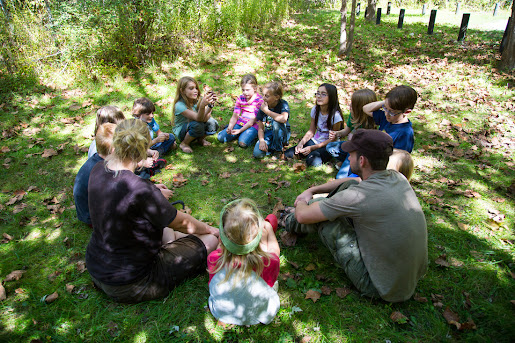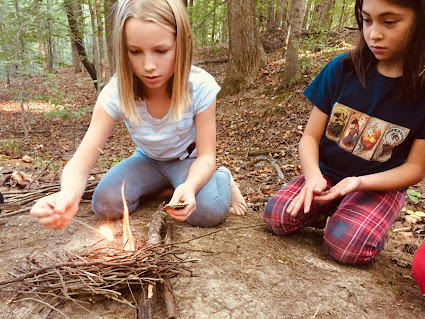2 Common Forest School Models: similarities and differences
Two Common Forest School Models
In the United States there are 2 main types of Forest Schools. One is the traditional
Forest School model that originated in Denmark in 1952. The idea formed as a result of a
group of neighbors and their children gathered together in a nearby forest. This new form of
daycare quickly attracted attention from other parents. This model has grown over the years
and now has 6 key principles to set forest school apart from traditional schooling and to guide
its processes and curriculum.

The 6 Principles:
1. Forest School is a long-term process of regular sessions, rather than one-off or infrequent visits. The cycle of planning, observation, adaptation and review links each session.
2. Forest School takes place in a natural or woodland environment to support the development of a lifelong relationship between the learner and the natural world.
3. Forest School aims to promote the holistic development of all involved, fostering resilient, confident, independent, and creative learners.
4. Forest School offers learners the opportunity to take supported risks appropriate to the environment and to themselves.
5. Forest School is run by qualified Forest School practitioners who continuously maintain and develop their professional practice.
6. Forest School uses a range of learner-centered processes to create a community for being, development, and learning.
Some of the common activities in this type of Forest School may include:
Creating toys, tools and handcrafts with found natural objects
Learning about the role of trees in nature and society
Discovering the relationship between earth and sky
Noticing the gradual changes of a natural landscape through the seasons
Exploring the complex ecosystem supported by a wilderness
Recognizing and identifying local flora and fauna
Embarking on imaginary voyages and expeditions
Practicing open-ended free play and memory games with loose parts
Playing imaginative games using role play and available resources
Building shelters or other structures from branches and natural materials
Counting objects or looking for mathematical patterns
Listening to stories; singing songs and rhymes
Drawing scenes or arranging natural items to create an image
Climbing trees and exploring the forest, playing hide-and-seek.
Self reflection, rest and meditation
This Forest School model is often for young children ages 0-6 years of age. The model I'll share below, however, is for all ages of kids, teens, and even adults.
Another Common Forest School Model
As mentioned above, there is another type of Forest School that originated in the United States in the 1990s. This one grew out of the teachings that Jon Young (author, tracker, naturalist, and bird language expert) brought forth through a training called “The Art of Mentoring”. This is the type of Forest School that I am most familiar with and have been studying and sharing since I was 19 years old (1999). This model draws on a lineage of nature-connection and life-ways of how to live close with the Earth. While we don’t discuss the 6 principles of a Forest School as stated above we can still check all of those boxes.
 |
| Teens work on making primitive bows from a hickory tree. |
 |
| A group of kids gather to share stories (with blog author Kevin) before setting out on a forest adventure. |
4 Aspects (or Ropes) of Connection:
Nature: we share this planet with many species of whom we seek to learn about through
observation, journaling, research, storytelling, and tracking.
Others: we are social beings and many of us have a deep desire to connect with other
humans to feel a sense of belonging and community.
Self: who am I? Why am I here? What gifts do I have to share with the world? We include
our sense of self as it relates to the whole.
Ancestors: where do I come from? What did people do before us? How did they thrive,
or teach their youth, or create connection, or heal?
Some common activities for this type of Forest School include:
- Naturalist studies & ecology including plants, trees, birds, reptiles, amphibians, and mammals.
- Cultivating a relationship with a sit spot: adopting a place on the landscape where you visit and practice sensory awareness, observing nature, and reflecting.
- Fire skills including building, lighting, tending, and cooking over a fire.
- Navigation including map & compass, aid-less navigation techniques, & creating maps.
- A culture of storytelling; sharing experiences, reflections, and teachings through stories.
- Building natural shelters.
- Using knives and tools safely.
- Learning wild edible and medicinal plants of your place.
- Understanding the tracks and signs of wildlife.
- Sensory awareness development.
- Expression and connection through song, music, and poetry.
As you can see, there is some overlap between these two types of Forest Schools. While the traditional European Forest School is often for younger children (forest kindergartens) the "art of mentoring" or 8 Shields Model type of Forest School can commonly be for all ages. Students can be guided on a multi-year journey from early childhood and into adulthood. With age comes greater responsibility in tool use and more intricate knowledge of local ecology and wilderness survival skills. There is no "better" school, just different approaches, curriculum, and lineage. I hope this helps you in your understanding. Please leave your questions in the comments section and I'll try and respond.
Remember to follow this blog for the latest posts.

Comments
Post a Comment